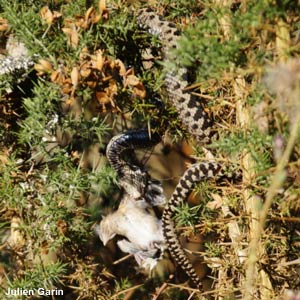Magazine | Analyses
Un cas de prédation d’une Vipère péliade sur un oisillon de Chardonneret élégant

Vipère péliade (Vipera berus) ayant attrapé un jeune Chardonneret élégant (Carduelis carduelis), étang de Careil, Iffendic (Ille-et-Vilaine), le 24/08/2015.Photographie : Julien Garin
Introduction
Si certains serpents arboricoles ou semi-arboricoles (genres Gonyosomas, Elaphes, Obsoletta ou Morelias….) se nourrissent essentiellement d’oiseaux, d’oisillons et d’oeufs, les vipères (genre Vipera) que l’on trouve en Europe, dont les moeurs sont généralement plus terrestres, chassent principalement les micromammifères, les lézards et les amphibiens. Toutefois, en fonction des opportunités, de leur âge et de la saison de l’année, elles peuvent aussi piller des nids, même si elles doivent pour cela grimper dans des arbustes. Le 24/08/2015, sur les rives de l’étang de Careil à Iffendic (département d’Ille-et-Vilaine, France), Julien Garin, Clément Charenton et Régis Gohier ont observé et photographié une Vipère péliade (Vipera berus) ayant attrapé un oisillon de Chardonneret élégant (Carduelis carduelis) dans son nid. Après une description de cette scène, nous abordons plusieurs points comme les techniques de chasse de ce reptile, le rôle supposé du motif sombre en zigzag sur son dos, les cas de certaines vipères dépendant du passage des migrateurs et les réactions de défense des oiseaux.
Abstract
If some arboreal or semi-arboreal snakes (genus Gonyosomas, Elaphes, Obsoletta ou Morelias for example) primarily prey on birds, chicks and/or eggs, vipers (genus Vipera) that can be found in Europe, that live primarily on the ground, hunt mainly micro-mammals, lizards and amphibians. However, following the opportunities, the age and the season of the year, they can also plunder nests, even if they have to climb a shrub. On 08.24.2015, on the banks of the pond of Careil near Iffendic (Ille-et-Vilaine department, Brittany, France), Julien Garin, Clement Charenton and Régis Gohier watched and photographed a European Adder (Vipera berus) catching a small Goldfinch (Carduelis carduelis) in its nest. After a description of the scene, we discuss several issues such as the hunting techniques of the European Adder, the supposed role of the dark zigzag pattern on its back, the cases of some vipers species depending on migratory birds and the birds mobbing snakes.
Poursuivez la lecture de cet article, en vous abonnant dès maintenant !
Découvrez les Archives d’Ornithomedia.com
Pour seulement 10,00 €TTC/an (ou 6,00 € les 6 mois)
Profitez de plusieurs centaines d’articles en accès illimité et sans aucun engagement.
Compléments
À lire aussi sur Ornithomedia.com
Sources
- Dinosoria. Vipère péliade. www.dinosoria.com/vipere_peliade.htm
- Natagora. La Vipère péliade. www.natagora.org/index.php?option=com_content&task=view&id=725&Itemid=39
- Dmitry A. Shitikov, Svetlana E. Fedotova et Victoria A. Gagieva (2012). Nest Survival, Predators and Breeding Performance of Booted Warblers Iduna caligata in the Abandoned Fields of the North of European Russia. Acta Ornithologica 47(2). Pages : 137-146. www.bioone.org/doi/abs/10.3161/000164512X662241
- Marcio Martins, Pedro F. Develey, Arthur Macarrão et Ivan Sazima (2012). The golden lancehead Bothrops insularis (Serpentes: Viperidae) relies on two seasonally plentiful bird species visiting its island habitat. Journal of Natural History. Volume 46, Numéros 13–14,. Pages : 885–895. http://eco.ib.usp.br/labvert/Bothrops-insularis-bird-prey.pdf
- Lee Kong Chian (2007). Birds mobbing snakes. Bird Ecology Group. www.besgroup.org/2007/11/14/birds-mobbing-snakes/
- Wolfgang Wüster, Christopher S. E. Allum, I. Birta Bjargardóttir, Kimberley L. Bailey, Karen J. Dawson, Jamel Guenioui, John Lewis, Joe McGurk, Alix G. Moore, Martti Niskanen, Christopher P. Pollard (2004). Do aposematism and Batesian mimicry require bright colours? A test, using European viper markings. Proceedings B. http://rspb.royalsocietypublishing.org/content/271/1556/2495.short
- Xavier Santos , Marta Vidal-García, José C. Brito, Soumia Fahd, Gustavo A. Llorente, Fernando Martínez-Freiría, Xavier Parellada, Juan M. Pleguezuelos et Neftalí Sillero (2014). Phylogeographic and environmental correlates support the cryptic function of the zigzag pattern in a European viper. Evolutionnary Ecology. Volume 28, numéro 4, pages : 611-626. http://rd.springer.com/article/10.1007/s10682-014-9699-6
- Luca M. Luiselli et Umberto Agrimi (1991). Composition and variation of the diet of Vipera aspis francisciredi in relation to age and reproductive stage. Amphibia-Reptilia, Volume 12, numéro 2, pages 137 – 144. http://booksandjournals.brillonline.com/content/journals/10.1163/156853891×00103
- Martti Niskanen et Johanna Mappes (2005). Significance of the dorsal zigzag pattern of Vipera latastei gaditana against avian predators. Journal of Animal Ecology. Volume 74 numéro 6. http://onlinelibrary.wiley.com/doi/10.1111/j.1365-2656.2005.01008.x/full
- Chloe Adamopoulou, Efstratios D. Valakos et Anastasios Legakis (1997). Notes on the diet and reproduction of the Cyclades Blunt-nosed Viper, Macrovipera schweizeri. Herpetozoa. Volume 10. Numéros 3/4. Pages : 173-175. www.zobodat.at/stable/pdf/HER_10_3_4_0173-0175.pdf
- Marc Paquay et Eric Graitso. la Vipère péliade. ORBI.http://orbi.ulg.ac.be/bitstream/2268/34888/1/622-ViperePeliade.pdf




 1 commentaire
1 commentaire
1 commentaire(s) sur ce sujet
Participer à la discussion !pierre broche
toulon
Posté le 23 juillet 2016
En Juillet 2013, j’ai pu observer une vipère en train d’avaler un petit oiseau (une mésange?). C’était visiblement difficile et je ne sais pas si elle est arrive au bout. Voir : http://les-randos-du-grand.eklablog.com/la-vipere-de-boutadiol-a126281042